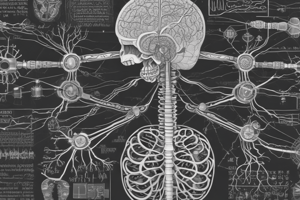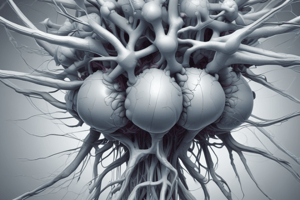Podcast
Questions and Answers
What is the nervous system responsible for?
What is the nervous system responsible for?
The nervous system is responsible for controlling, regulating, and communicating in the body, as well as regulating and maintaining homeostasis.
What are the principal organs of the nervous system?
What are the principal organs of the nervous system?
The principal organs of the nervous system are the brain, spinal cord, nerves, and ganglia.
What are the various tissues that make up the nervous system?
What are the various tissues that make up the nervous system?
The various tissues that make up the nervous system include nerve, blood, and connective tissue.
What are the general, overlapping functions of the nervous system?
What are the general, overlapping functions of the nervous system?
How does the nervous system keep us in touch with our environment?
How does the nervous system keep us in touch with our environment?
Flashcards are hidden until you start studying
Study Notes
Nervous System Overview
- Responsible for coordinating body functions, initiating responses to stimuli, and processing sensory information.
- Plays a crucial role in maintaining homeostasis and enables communication between different body parts.
Principal Organs
- Brain: Central control unit, processes information and controls responses.
- Spinal cord: Transmits signals between the brain and the rest of the body, responsible for reflex actions.
- Nerves: Networks that carry signals to and from the brain and spinal cord, connecting to muscles and organs.
Tissues of the Nervous System
- Neurons: Specialized cells that transmit electrical signals throughout the body.
- Glial cells: Supportive cells that protect, nourish, and maintain homeostasis for neurons.
- Myelin sheath: Fatty tissue that surrounds axons, enhancing signal transmission speed.
Functions of the Nervous System
- Sensory input: Detects and interprets changes in the environment through sensory organs.
- Integration: Processes and interprets sensory input to formulate responses.
- Motor output: Initiates actions by sending signals to muscles and glands.
Interaction with the Environment
- Receives sensory information through receptors in the skin, eyes, ears, and other organs.
- Processes this information in the central nervous system to create appropriate responses, enabling interaction with surroundings.
- Facilitates reflex actions that provide immediate responses to environmental stimuli, enhancing survival.
Studying That Suits You
Use AI to generate personalized quizzes and flashcards to suit your learning preferences.




